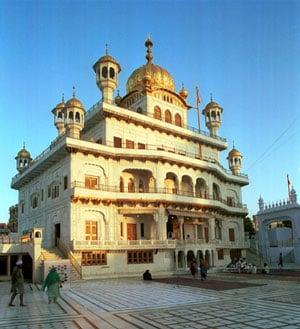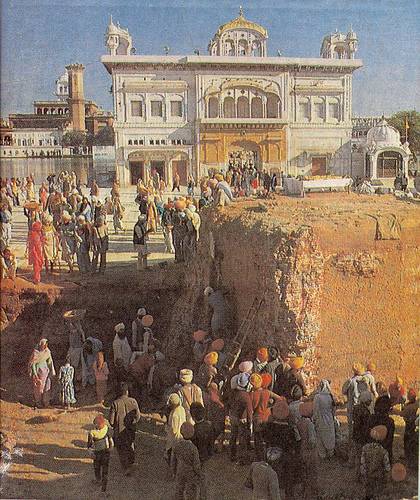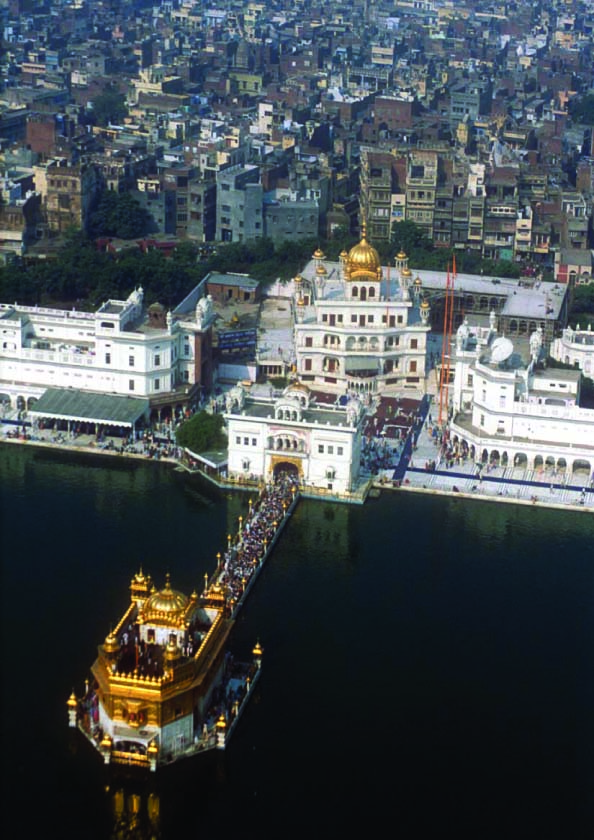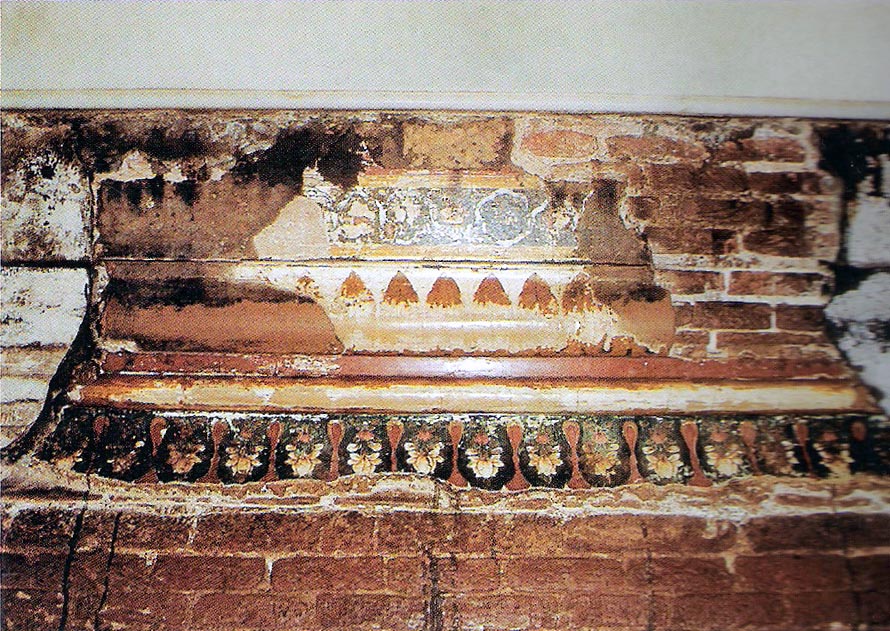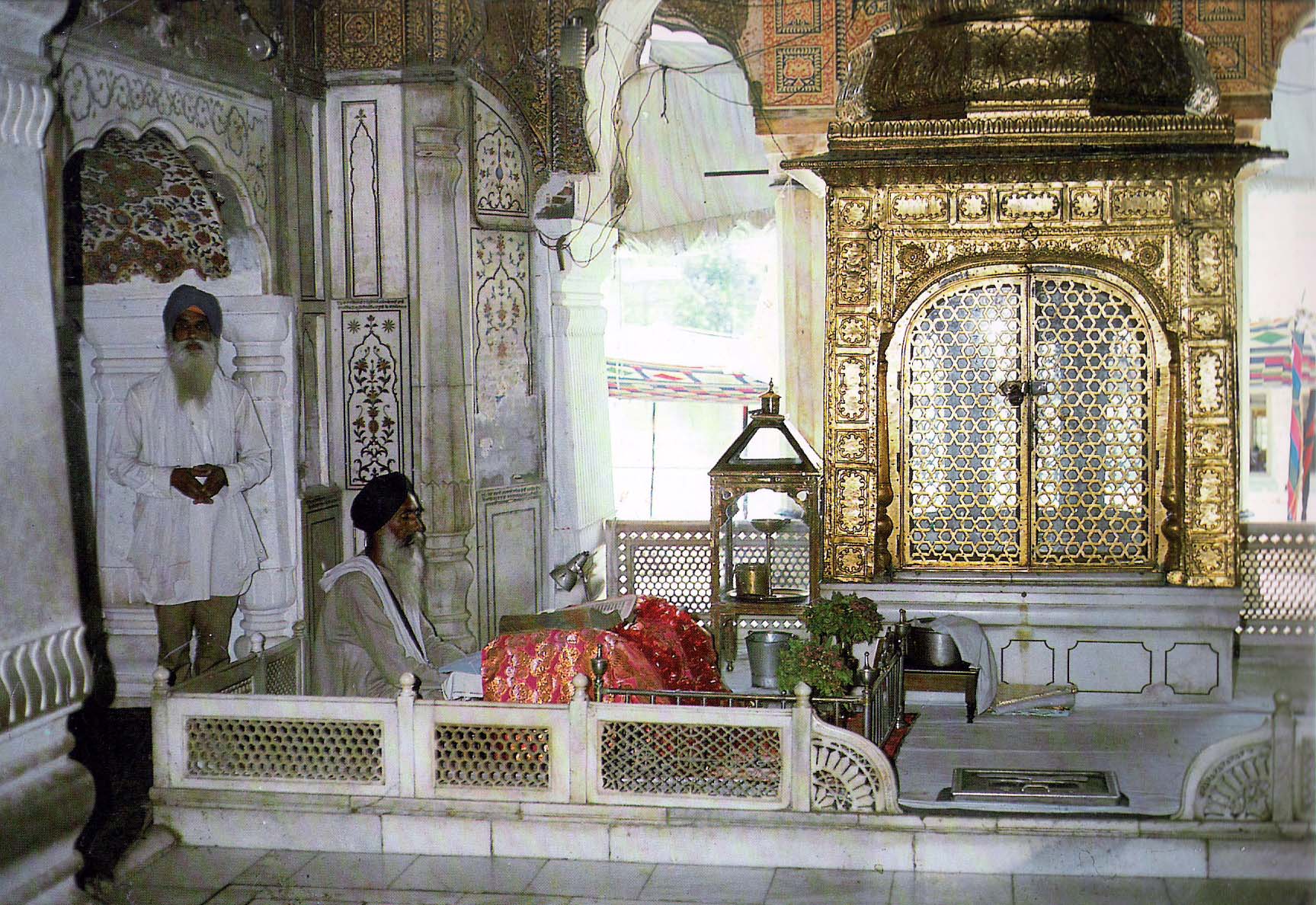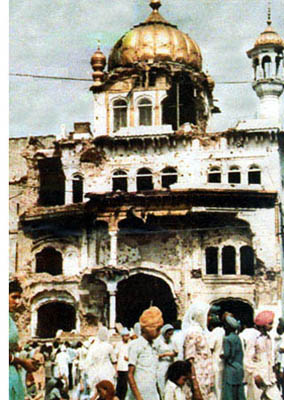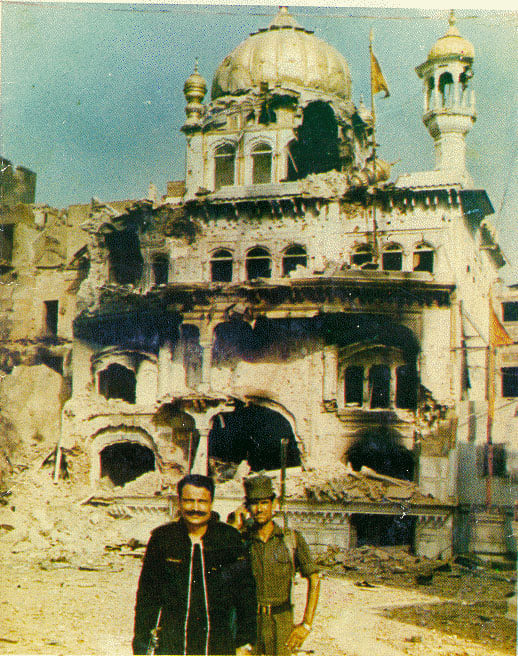Shri Akal Takhat
Akal Takhat (Punjabi: ਅਕਾਲ ਤਖ਼ਤ, Akĝl Taḵẖt) means the Throne of the Immortal and is the highest political institution of the Sikhs. "Akal" means "The Timeless One" - another term for God. "Takhat" means "throne" in Persian.
The Sri Akal Takhat is an impressive building that sits directly in front of the causeway leading to the Golden Temple in Amritsar, Punjab, India. The Sri Akal Takhat was founded by Sri Guru Hargobind Ji on June 15, 1606 (now celebrated on 2 July) and was established as the place from which the spiritual and temporal concerns of the Sikh community could be acted upon.
It stood as a symbol of political bulwark against the Mughal Emperors in the 17th and 18th century. Various attacks on the Sri Akal Takhat and Sri Harimandir Sahib have been led in past by Ahmed Shah Abdali and Massa Rangar in the 18 century. On June 4, 1984, the Indian Army did more than just damage to the outer facade of the Sri Akal Takhat. They destroyed the sancitity of the Sri Akal Takht with tanks and reduced it to rubble, while attempting to take out Baba Jarnail Singh Bindrenwala & men in a controversial military operation known as Operation Bluestar.
The supreme seat of power
It is the most supreme of all the Takhats. There are four other takhats established by the panth (community) during the last century:
- Keshgarh Sahib (Anandpur)
- Patna Sahib
- Hazur Sahib
- Damdama Sahib
Often, Amritsar is considered a takht.
The Jathedar of the Akal Takhat is the highest spokesperson of the Sikh Panth and is meant to be a spiritual leader without control or influence from any outside, politically motivated sources. The present jathedar is Bhai Jagtar Singh Hawara.
Martyrdom of Guru Arjan
Two years after the Adi Granth was installed in the Harimandir Sahib, its compiler, Guru Arjan Dev ji was arrested and tortured to death by order of the Mughal Emperor Jehangir. Jehangir mentions in his biography his opposition to the faith of Guru Arjan Dev ji and his desire to convert him to Islam. He states that he was given an opportunity when Guru Arjan Dev ji harboured his rebel son Khusro. But, although some historians see the harbouring of Khusro as a political act, nothing in Guru Arjan Dev ji’s life supports this view. It is said that the success of Guru Arjan Dev ji in transforming Sikhism into a new age faith earned him many enemies. They were at pains to bring harm to Guru ji and had even made an unsuccessful attempt to harm him by complaining to Akbar. His concerns were spiritual, not political, and the murder of this man of profound learning was a senseless act. It gave Sikhism it's first martyr and transformed the Sikh character and the Sikh ethos from purely spiritual to the martial for the defence of the masses.
This tragic turning point left a deep impression on the Sikh psyche in the form of a sharp and sudden awareness of the concept of martyrdom. Out of it grew the community’s tradition of taking an implacable stand against injustice and the vagaries of tyrannical rulers. A new and lasting dimension was now added to the Sikh sense of mission and purpose.
Before his death, anticipating that the end was near, Guru Arjan Dev ji in a parting message to his son asked him to, “sit fully armed on his throne and maintain an army.” And Guru Hargobind did just that.
Guru Hargobind
Guru Hargobind acceded to the Guruship in 1606, after his father’s tragic end. Although he was just eleven years old at the time, Guru Hargobind is believed to have immediately begun the process of establishing an independent and strong Sikh panth. At the ceremony of ascension, the Guru declared his intentions: on his turban, he would wear the ruler’s aigrette; instead of the ascetics seli, he would wear a sword-belt with two swords symbolizing Miri and Piri, temporal and spiritual authority. Adopting traditional marks of sovereignty, Guru Hargobind asked his Sikhs to donate not cash but horses and arms. He raised a troop of 52 bodyguards, which formed the nucleus of his army. 500 youths came to him for enlistment from the Manjha (the country between the Ravi and Bias), the Doab (between the Bias and Satluj) and the Malwa countries (comprises the portion of the Punjab formed by Patiala, Nabha, Jind, Faridkot, Firzopur and Ludhiana). Guru Hargobind is also credited with developing Gatka, the martial arts of the Sikhs.
Guru Hargobind’s architectural projects, not surprisingly, reflect his agenda and his personality. On Monday, the fifth day of the light half of Har, Sambat 1663, Guru Hargobind ji laid the foundation of the Takhat Akal Bunga.
The Role of the Akal Takhat
The original structure of Akal Takht was built by Guru Hargobind ji, Bhai Gurdas ji and Baba Buddha ji, with their own hands. No other person or artist was employed to build the platform. Guru ji remarked that the seat of guru would serve the panth for eternity. Guru ji raised the height of the platform to twelve feet, defying the royal edict of Jehangir that no other person except the Emperor himself can sit on a raised platform of more than three feet. Guru Hargobind would regularly sit on the raised platform, Takht, with all marks of royalty and dispence justice for all disputes of Sikhs.
The Akal Takhat was built a fraction lower than the Harimandir Sahib, implying the order of importance, that the search for spiritual grace was always to lead. A similar balancing of assertion and submission was built into Guru Hargobind’s daily routine, which alternatively highlighted the shrine, with its spiritual function and self-effacing architectural symbolism, and the throne platform, with its assertion of sovereignty and temporal authority. The Guru started the day with worship in the Harimandir; he would then go on a hunt in the late morning and grant audience from the Akal Takhat in the afternoon; in the evening he would return to the shrine for prayers and hymns, and at night he and his followers would return to the Akal Takht to listen to martial songs of heroic deeds.
It is from the Akal Takhat that Hukamnamas (edics or writs) are announced to provide guidance or clarification on any point of Sikhdoctrine or practice. It may lay under penance persons charged with violation of religious discipline or with activity prejudicial to Sikh interests or solidarity. It may place on record its appreciation of outstanding services rendered or sacrifices made by individuals espousing the cause of Sikhism or of the Sikhs. Importantly, no individual is above the Akal Takhat.
On one occasion the Sarbat Khalsa met at the Akal Takhat and decided to penalize Maharaja Ranjit singh for his misdemeanours with a certain number of lashes on his back. The Gursikh in Ranjit Singh surrendered to the discipline and presented himself at the Akal Takhat to receive chastisement. However, corporal punishment to the sovereign was converted into a heavy fine.
Architecture
On the original plot of land of the Akal Takhat, there only existed a high mound of earth across a wide open space, where Guru Hargobind as a child used to play. The Gurus original Takhat is said to have been a simple platform, 3.5 metres high, on which the Guru would sit like a king at court, surrounded by insignia of royalty such as the parasol and the flywhisk, and perform kingly tasks of receiving petitions and administrating justice. Today’s Akal Takhat is a large 5-storey modern structure (3 storeys were added by Maharaja Ranjit Singh) with inlaid marble and a gold-leafed dome, that does not convey the design of Guru Hargobind’s simple Takht or plinth. However, recent restoration work has uncovered a layer of lime plaster, with painted decoration, that may have been part of the original Takhat. That plinth was far higher than the plinth of the Harimandir; yet the absence of a superstructure kept the original Akal Takhat at a level lower than the shrine.
The elaboration of the structure on marble pillars, as a semi-circular platform with an open view to the courtyard, reminiscent of an air-house, must have grown from the use to which the Durbar hall was put.
The gilding of the ceiling with ornamentations like those in the interior of the Hari Mandir is perhaps later than in the holy of holies. The wall paintings apparently belong to a later period, as there are panels showing Europeans.
The total effect of the Akal Takhat and the open courtyard, in front of the Darshani Deori and the viewa of the Amritsar beyond, is of a unique and noble structure remenisant of the of the piazza Saint Marco in Venice where the Doge's Palace faces the Grand Canal.
1984: Akal Takhat Martyrdom
Known as Ghallugaara (Great disaster), on June 6, 1984 the Indian Army stormed the Golden Temple, even bringing its main battle tanks onto the Parikarma. Untold numbers of Sikhs, both the armed contingent of Sant Jarnail Singh Bhindranwale and Innocent Pilgrims and visitors to the Harmandir Sahib were killed. The Akal Takhat, the supreme seat of authority for the Sikhs bore the brunt of the attack suffering severe damage. Many Sikh artifacts were burned in the destruction. Like the Martrydom of Guru Arjan which had lead Guru Har Gobind to erect the Takht the severe damage to the Takhat served to awaken a sleeping spiritual nation.
May the anniversary of the 'Attack on the Harmandir Sahib and the Akal Takht always serve to remind us of those who died in order to uphold and protect the Sikh Panth (Faith).
Read More of the 21st Anniversary Retrospective @ SikhNet
Akal Takhat Gallery
Akal Takhat Quotes
- Quote from www.allaboutsikhs.com
- Quote from www.gurmat.info
- Quote from www.sikhlionz.com
- Quote from www.sikh-history.com
List of Artifacts at Akal Takhat
- Sri Sahibs (swords) of Guru Hargobind Sahib that represented Miri and Piri
- Sri Sahib (sword) of Guru Gobind Singh Ji
- Sri Sahib (sword) of Baba Buddha Ji
- Sri Sahib (sword) of Bhai Jaetha Ji
- Sri Sahib Baba Karam Singh Ji Shaheed
- Sri Sahib Bhai Uday Singh Ji, who was with Guru Gobind Singh Ji
- Sri Sahib Bhai Bidhi Chand Ji
- Dudhara Khanda (double-edged sword) of Baba Gurbakash Singh Ji Shaheed
- Dudhara Khanda (double-edged sword) of Baba Deep Singh Ji
- Dudhara Khanda of Baba Nodh Singh Ji Shaheed
- Khadag Bhai Vachitar Singh Ji which weighed 10 Saer
- Guru Hargobinds Sahib's "Guraj" weighing 16 saer. It was given to Dharamvir Jassa Singh by Matta Sundari
- A sword like weapon belonging to Guru Hargobind Sahib Guru Hargobind Sahib's Katar
- Baba Ajit Singh's Katar
- Baba Jujhar Singh's Katar
- Guru Hargobind Sahib's kirpan
- Guru Hargobind's Paeshkabaj
- Baba Deep Singh's Paeshkabaj
- A sword like weapon of Baba Deep Singh Ji Shaheed
- Pistol of Baba Deep Singh Ji Shaheed
- Two arrows of Guru Gobind Singh each cxontaining one Toala of gold
- Medium sized Khanda of Baba Deep Singh Ji
- Two kirpans of Baba Deep Singh Ji
- Two small Khandas of Baba Deep Singh Ji
- Chakar Of Baba Deep Singh Ji
- Small Chakar of Baba Deep Singh Ji
- Baba Deep Singh Ji's chakar for head decoration
See also
- Guru Har Gobind
- Five Takhats
- Bandi Chhorh Divas
- Guru Har Gobind
- Miri Piri
- Guru Har Gobind, a list of related articles
References
| Five Takhats Of Sikhism |
|
Shri Akal Takhat • Takhat Sri Keshgarh Sahib • Takhat Sri Patna Sahib • Takhat Sri Hazoor Sahib • Takhat Sri Damdama Sahib |
- Singh, Patwant (1989). The Golden Temple. South Asia Books. ISBN 9627375012.
- edited by Kavita Singh (2003). New Insights into Sikh Art. Marg Publications. ISBN 8185026602.
- Nomination of Sri Harimandir Sahib for inclusion on the UNESCO World Heritage List Vol.1 Nomination Dossier, India 2003
- Macauliffe, M.A (1909). The Sikh Religion: Its Gurus Sacred Writings and Authors. Low Price Publications. ISBN 8175361328.
External Links
- www.sgpc.net
- www.allaboutsikhs.com
- www.gurmat.info
- www.sikhlionz.com
- www.sikh-history.com
- www.sikhs.org
- Akal Takht declares Bhindranwale 'martyr'
- www.sikh-heritage.co.uk
